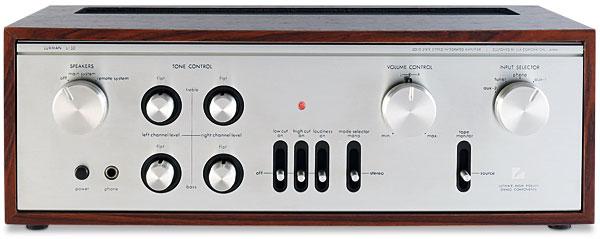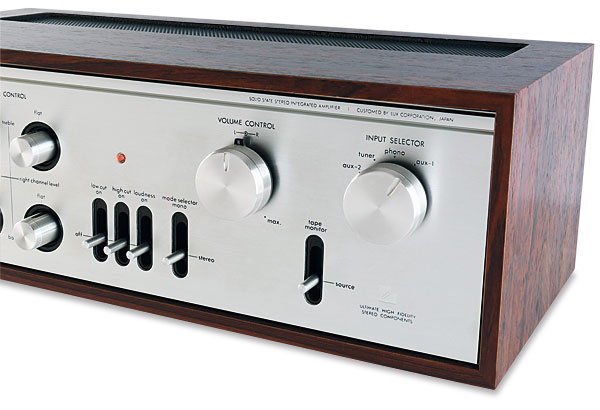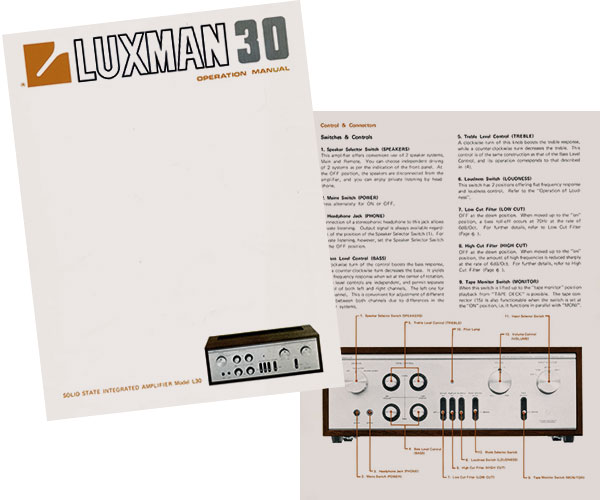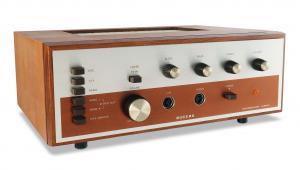Luxman L-30 Amplifier

 With retro styling currently all the rage how will this integrated compare, especially considering it was the most affordable amp in Luxman's mid-'70s lineup? We find out
With retro styling currently all the rage how will this integrated compare, especially considering it was the most affordable amp in Luxman's mid-'70s lineup? We find out
The L-30 was the cheapest amplifier in Luxman's 1976 range. Not that it looked anything like a budget model – rather, it had an almost intangible feel of quality and superior finish that in terms of showroom appeal put it above all but the very best offerings from the Japanese big names at the time.
At around £180, the L-30 occupied a place in the market where amplifiers began to be considered of interest to the more serious listener. For the same money you could also have had a Sony TA-3650 or Sansui AU-5900, fine units both. For those who preferred British equipment a Cambridge P80 or a Sugden A48, both of which were well regarded at the time, cost about the same as the L-30. This, then, was the point of entry to the Luxman range, which went up to an eye-watering £11,000 for the M-4000 power amplifier – the most expensive standard production model on sale in the UK at the time.
Simple Minded
The L-30 was a simple, yet well executed, package. It was rated at 32W per channel into 8ohm, which again represented something of a dividing line between the run-of-the-mill amps and the more specialised fare. All the facilities one would require for a basic system were present, from a built-in phono stage that suited the bulk of MM cartridges in use at the time, through to switched outputs for two pairs of loudspeakers and a pair of headphones. Just as with every Japanese amplifier of the 1970s, a matching tuner was also available – the T-33. Both shared an unusually shallow cabinet, making them suitable for placement on the shelving units that were fashionable in homes of the period.

At a time when hi-fi technology was surging forward in leaps and bounds, the L-30 was a surprisingly conservative design. Key to the circuit was its simplicity at all stages – this when the number of components being used by the company's rivals were expanding greatly year by year. The amp was built around a DC-coupled output stage running under Class AB conditions. This method, where there are no coupling capacitors or transformers between the output transistors and the loudspeaker load, gave consistent performance and made speaker matching reasonably straightforward. The downside of DC coupling is that it renders the amp's power transistors vulnerable to common user mistakes, such as when the loudspeaker connections are inadvertently short circuited. It also places the woofers in loudspeakers directly across the amplifier's power supply should something go wrong, which would quickly damage them.
Feedback 'N' Fuses
By this stage, many of the large Japanese companies had evolved automatic circuits based around relays and electronic control systems that disconnected the amplifier from the loudspeakers should anything go wrong. They also isolated the speakers from the amplifier for a few seconds after switching on, eliminating the familiar 'thud', which was the hallmark of many of the early DC-coupled designs.
The L-30 did without all of this and instead used multiple fuses to protect all the system components. It was common practice in cheaper amplifiers to place a fuse in series with the loudspeaker outputs, but this also has undesirable effects. A fuse changes its resistance slightly as the power it dissipates alters, so with a complex music signal it can be shown to be a source of distortion. This would be a particular problem at high volume levels so Luxman included the fuses in the positive and negative supply rails to each output stage instead. Using this arrangement the circuit as a whole (including the four extra fuses) was linearised by the action of the amp's feedback loop – a useful refinement.

Active Action
More careful design could be found in the preamplifier, which received its power from an active filter circuit which minimised the amount of hum introduced at this point. Passive high- and low-pass filters were included at the inputs of the preamp and when using the line-level inputs (tuner, tape, etc) the volume control preceded all the active stages, meaning that when normal sources were used it was impossible to overload the input of the amplifier.
The tone controls were active and described as being of the 'Lux type', although the circuit was largely conventional in its layout. The phono stage was also of a familiar design, but in line with the theme of simplicity in the signal path it used only two transistors per channel – compare this to the Gothically complex external phono stages of today!
The L-30 was only current in the range for a year. It was replaced in 1977 by the almost identical L-31 whose main improvement was a marginal increase in output power to around 40W per channel. This would have made almost no difference when it came to everyday listening, but was important for marketing reasons since in 1970s hi-fi culture the manufacturer's claimed power output was one of the key ways the status of an amp was determined.

Seeing the L-30 today is an intriguing experience. A few years ago it would have been obvious that it was a vintage model but with the recent trend for reissuing yesterday's favourites (albeit with modern insides) it is harder to tell. If someone had told me the L-30 was new I'd have been none the wiser, until I was close enough to smell the distinctive and delightful aroma of old Japanese electronics (they haven't managed to copy that yet!).
DIY Centre
The only obvious ergonomic drawback here is the use of separate treble and bass controls for each channel, something I can see no purpose or justification for, other than to reduce the (unlikely) possibility of crosstalk inside the controls themselves. Tone controls should not be necessary in any case, and they are all best left at their centre position. This would be easier to do if a centre click-stop had been provided, but it has not, and trying to line up the four knobs exactly will be a source of unending frustration! The controls do at least have a limited range of operation so they 'trim' rather than generate a needlessly large effect. Similar comments apply to the loudness switch, which works well enough but should always be out of circuit for critical listening.























































